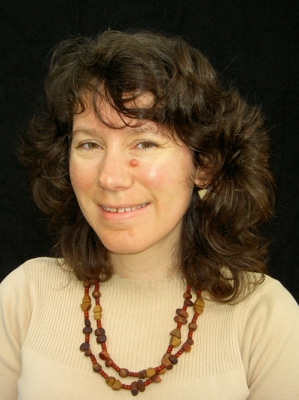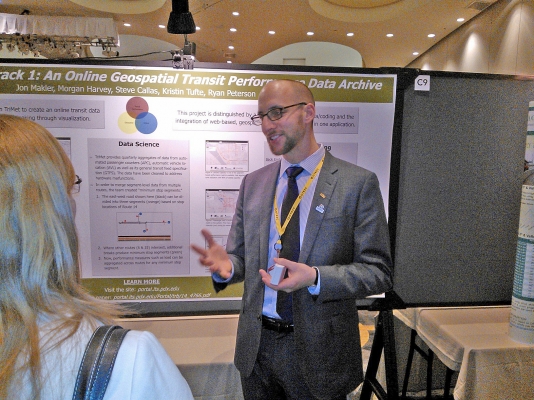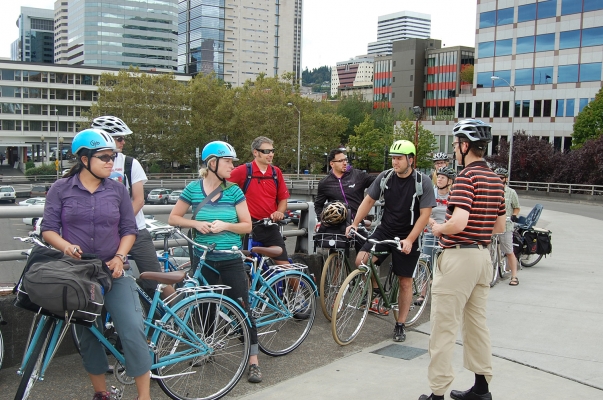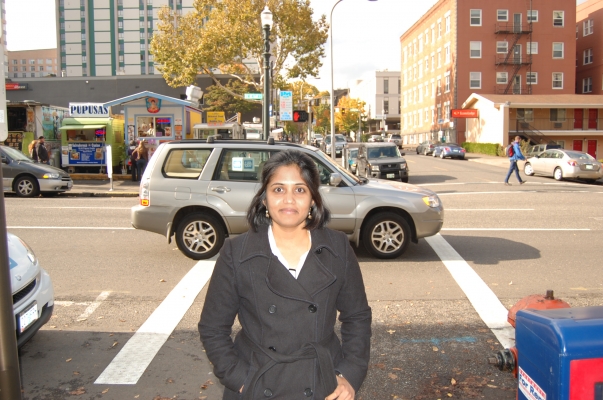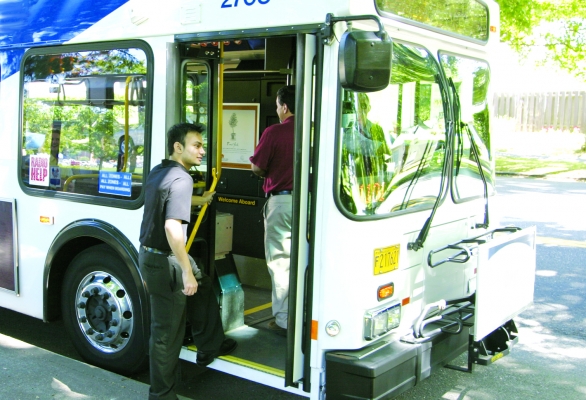Krista Nordback, an OTREC staff researcher, won the Outstanding Paper award from the Transportation Research Board's Bicycle Transportation Committee. The award honors Nordback's paper, "Measuring Traffic Reduction from Bicycle Commuting," which was also featured here:
https://trec.pdx.edu/OTRECUS/news/entry/does_driving_drop_when_cycling_spikes
The paper marked the first research to document a statistically significant drop in motor vehicle traffic during a bike-to-work event. The paper is available to download here or through the link above.
The award is given to the best paper submitted to the Committee on Bicycle Transportation for the 2014 TRB annual meeting, held Jan. 12-16 in Washington, D.C. The committee reviewed 85 papers, using anonymous peer reviewers and committee members.
More information on OTREC's presence at the TRB annual meeting is at:
https://trec.pdx.edu/OTRECUS/news/otrec_at_trb
Information on the Committee on Bicycle Transportation is at:
A new tool added to Portland State University's regional transportation data archive can help transit agencies and riders alike make better decisions. The Portland State-based team presented its work at the Transportation Research Board annual meeting Monday in Washington, D.C.
The team worked with the Portland regional transit agency, TriMet, to make the transit data richer and more useful. Starting with an offline, GIS-based protocol for mapping ridership and service metrics, the team developed an online, interactive map that offers myriad possibilities for users of all types.
Many applications offer schedule data for passengers or operational data for agencies, but none join both types of data in a customizable, Web interface, said project leader Jon Makler. "People would look at this and say, 'It would be amazing if we could put all of this stuff in the same system,'" Makler said. "But they see the work that it requires and they back away."
Here's one way the archive can help transit agencies: Managers receive complaints about bus crowding at certain times on certain routes. They ask an analyst to pull the data, and the analyst returns with a spreadsheet of arcane route and stop numbers. "The managers say, 'That doesn't mean anything to me,'" Makler said.
With the transit archive, those managers can now pull up a route map online and see all the segments that...
Read moreNote: In advance of the Transportation Research Board's annual meeting, the biggest forum on the transportation research calendar, OTREC.us is profiling some of the researchers who will present their work.
In transit-oriented development, planners typically focus on the neighborhood within a quarter of a mile of a transit stop.
Housing and commercial developments within this "walkable zone" are thought to be the ones primarily affected by, or dependent on, the transit stop.
New research from the University of Utah expands the traditional one-quarter-mile distance away from transit stops to a broader radius of about one and one-quarter mile from a stop.
The project's principal investigator, Susan Petheram, led a team of researchers who used the Salt Lake County assessor's database to analyze property values surrounding light rail stops. Petheram is a NITC doctoral dissertation fellow and the research stems from her dissertation.
"We were seeing a certain negative impact [on property values] right around the core station area for single family homes," Petheram said. Slightly...
Read moreThe Initiative for Bicycle and Pedestrian Innovation has unveiled the most ambitious year of professional development offerings in its history.
For the first time, the schedule includes Webinars, with the first taking place Feb. 27. Offerings also include courses and workshops geared toward practitioners and university faculty members. There’s also a two-week study abroad opportunity to learn about sustainable transportation in the Netherlands.
The course offerings include a newly added advanced bicycle design and engineering workshop. The workshop is geared toward professionals who have taken the original IBPI course or who serve communities with a developed bicycle network.
“More than 120 professionals have taken the course since 2008,” said Hau Hagedorn, who manages the IBPI program. “We’ve reached the threshold of educating professionals where there’s the need to take this to the next level of expertise.”
Continuing education credits are available for each workshop and Webinar. Click here for details on the individual course pages.
Registration is now open for IBPI’s inaugural Webinar on Feb. 27: “We are Traffic: Creating Robust Bicycle and Pedestrian Count Programs.” As agencies looking to improve bicycle and pedestrian infrastructure have learned, it doesn’t count if it’s not counted....
Read moreNote: In advance of the Transportation Research Board's annual meeting, the biggest forum on the transportation research calendar, OTREC.us is profiling some of the researchers who will present their work.
In a session titled "Living Within the Right-of-Way: New Address for the Homeless," OTREC researcher Andrée Tremoulet will give a lectern presentation about her research into homelessness.
Encampments of homeless individuals and families living in state department of transportation rights of way often pose a unique challenge for DOT staff responsible for maintaining the public land.
The solution, as described in Tremoulet's report, is as complex and multifaceted as the problem.
In cases where urban campers need to be relocated, for the process to be humane and successful Tremoulet stresses that it must be achieved through a cooperative effort between community orgnizations.
She advocates using a "push/pull" method, combining the "push" of law enforcement to clear the public land with the "pull" of assistance and housing programs to give homeless individuals direction, and a place to go.
The most important thing to remember, she says, is that no situation is alike and every set of circumstances will require a unique, tailored approach.
Following the publication of this OTREC project about a homeless relocation...
Read moreNote: In advance of the Transportation Research Board's annual meeting, the biggest forum on the transportation research calendar, OTREC.us is profiling some of the researchers who will present their work.
How long is too long to wait for the light to change? At stoplights, pedestrians often experience longer delays while cars are given priority.
To design traffic signals that serve the needs of walkers, planners must understand the motivations behind pedestrian behaviors.
Working with professors Kelly Clifton and Christopher Monsere, Sirisha Kothuri of Portland State University created a survey designed to shed some light on what makes pedestrians decide to follow, or not follow, traffic laws.
To collect data, Kothuri and a team of graduate students armed with an 11-question survey posted themselves at four different intersections in northeast Portland, Ore.
Two of the intersections had recall signals, where pedestrians are automatically detected, and the other two had actuated signals, where pedestrians must press a button to get the light to change.
Survey respondents were asked for their attitudes about delay in signal timing, and for the reasons that determined their crossing the street.
Responses showed...
Read more
OTREC research played a prominent role at this year’s Transportation Research Board annual meeting, the preeminent national conference for transportation researchers. An estimated 12,000 transportation professionals from around the world are attending the conference.
A total of 75 affiliated researchers from three campuses of OTREC’s NITC program present their research in 64 lectern and poster sessions Jan. 12-16. Faculty and students presided or presented at an additional 16 workshops, committee meetings and sessions.
Potential presenters at TRB submit full research papers for peer review; only around half of the submitted papers are chosen for presentation at the annual meeting. Portland State University researchers had 41 papers accepted for presentation; University of Oregon, 3; University of Utah, 20. Portland State, University of Oregon, Oregon Institute of Technology and the University of Utah are partners in the National Institute for Transportation and Communities, or NITC, program. (New NITC partner...
Read moreNote: In advance of the Transportation Research Board's annual meeting, the biggest forum on the transportation research calendar, OTREC.us is profiling some of the researchers who will present their work.
The bicycle counts suggested that, on Bike to Work Day, more people did bike to work. But did fewer people drive?
OTREC staff researcher Krista Nordback took up the issue and will present her findings Monday, Jan. 13 at the Transportation Research Board’s annual meeting in Washington, D.C.
The bike count data from sites across Boulder, Colo., certainly impressed Nordback. “Bike to Work Day has this huge spike,” she said. “The bike counts double at a lot of the count sites.
“Wouldn’t it be cool if we could see something similar with the motor vehicle count data?”
In a twist that might only happen in Boulder, with its ample bike counters, Nordback had a harder time tracking down the motor vehicle counts. She lucked out, finding that the city’s red-light cameras had been counting cars alongside their primary job of catching red-light runners.
Those motor vehicle counts showed a consistent drop on Bike-to-Work days compared with average workdays in June and July. It was a small drop, but even finding that was unprecedented: no studies had documented a statistically significant drop in motor vehicle counts during any bike-to-work event.
...
Read more
